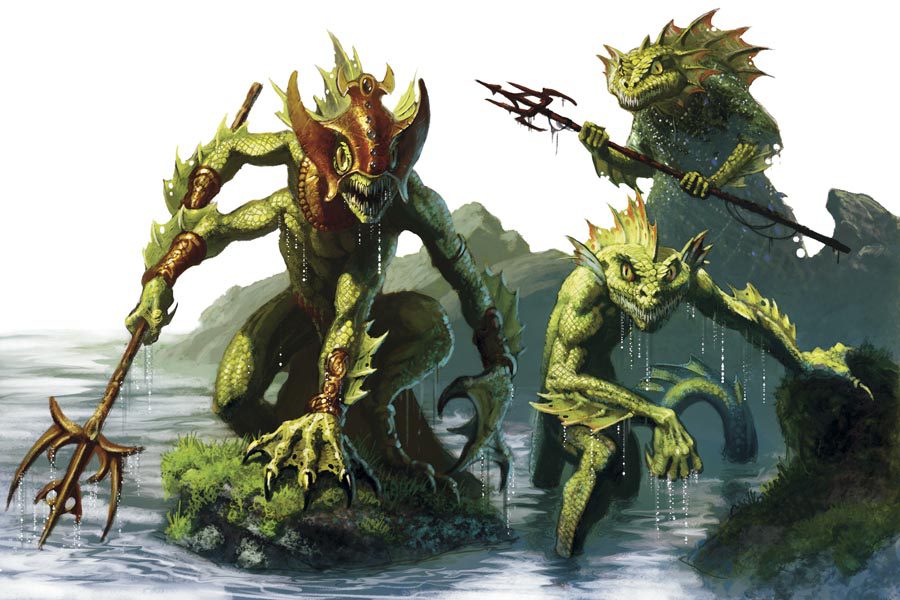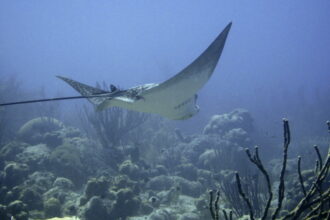10 Awesome Monsters for a D&D 5e Aquatic Encounter

Aquatic | Arctic | Cave or Underground | Desert | Forest | Grassland | Jungle | Mountain | Swamp
Looking to run an aquatic adventure of a full underwater campaign? Check out Under the Seas of Vodari.
Arrrh matey! Looking to have your adventurers walk the plank or explore a lost temple deep under the sea? We have you covered. Here is a list of 10 Awesome Monsters for an Aquatic Encounter from the Dungeons & Dragons 5th Edition Monster Manual. Don’t forget to check out Aquatic Monster & Hero Race Options if you are looking for new player options for your campaign.
NOTE: Since this was first published in October 2014 the Dungeon Master Guide was released and provides lists of Monsters by Environment (such as coastal or underwater) in Appendix B, but the lists are basic. In this article, you’ll find monsters that I think fit in an underwater setting and some ideas on how to create encounters with each of them.
-
Aboleth
Challenge Rating: 10
Aboleths use telepathy, tentacles and other devastating attacks to kill heroes. Create a legendary encounter in an Aboleth lair located in a subterranean lake or in the fallen ruins of an ancient underwater city. -
Chuul
Challenge Rating: 4
The amphibious chuul can be used to follow their master’s orders tirelessly or use their ability to sense magic to chase down adventurers with magic items. -
Dragon Turtle
Challenge Rating: 17
This fearsome marine monster is dangerous dragon of the deep. If your heroes want to avoid a having their ship sunk, a dragon turtle is smart and greedy enough to be bribed with treasure to fill its lair. -
Kraken
Challenge Rating: 23
Release a kraken on super powerful heroes, to create a natural disaster or as a god at the top of a cult. This gargantuan monstrosity is made even more powerful when you place it in its lair. -
Kuo-Toa
Challenge Rating: 1/4
These fishlike humanoids will not put up much of a fight, but who does not want to squish some evil fish? They once inhabited shores and islands before madness drove them underground. With their sunlight sensitivity, they are best used in a subterranean lake setting, but you could easily tweak them for some island fun. -
Marid
Challenge Rating: 11
This piscine looking genie can be used as a powerful foe or can be used as a storyteller to reveal important details to your adventurers. -
Merrow
Challenge Rating: 2
Merrow are corrupted merfolk who will attack fisherfolk, merfolk and any other edible creatures unfortunate enough to cross their path. Merrow could be found in undersea caves filled with treasure when they are not raiding. -
Plesiosaurus
Challenge Rating: 2
This marine dinosaur is an aggressive predator with a powerful bite. A battle with a Plesiosaurus could act as a clue that the adventurers are sailing towards a lost world that is from long ago. -
Sahuagin
Challenge Rating: 1/2 to 5
Sahuagin are worshippers of the shark god Sekohah and they really, really hate aquatic elves. Lots of variety is available with Sahuagin, Sahuagin Priestess and the powerful 4 armed Sahuagin Baron. -
Sea Hag
Challenge Rating: 2
The ugliest of all hags, sea hags live in dirty underwater liars surrounded by merrow and other aquatic monsters. Sea hags are amphibious and can create problems for adventurers with their illusions, claws and a death glare.
Bonus Monsters
- Crocodile & Giant Crocodile
- Dragon, Blue (rocky coast when not in more typical desert lair)
- Dragon, Bronze (coastal)
- Giant Crab
- Giant Frog
- Giant Octopus
- Giant Sea Horse
- Hunter Shark
- Hydra
- Killer Whale
- Reef Shark
- Storm Giant
- Swarm of Quipper
- Water Elemental
- Water Weird
- Leviathan
Aquatic Hazards
Frigid Cold & Crushing Pressure
Many undersea creatures are accustomed to the deepest seas and have resistance to cold damage and can ignore any of the drawbacks caused by a deep, underwater environment. For others, magic items and spells can provide the ability to dive into this deep and unforgiving environment. Those without protection from the frigid cold and crushing pressure of the depths may find death quickly. Consult the DMG for details on handling frigid water (page 110) and crushing pressure (page 116).
For characters looking to travel into deeper seas, the following optional rule can be used.
A character with a swimming speed and the ability to breathe water can comfortably travel to the deeps of up to 650 feet. Characters without the ability to ignore any of the drawbacks caused by a deep, underwater environment will find it uncomfortable to swim to deeper waters and have the following restrictions:
- For each hour spent at depths greater than 650 feet and up to 1,000 feet, a character must succeed on a DC 10 Constitution saving throw or gain one level of exhaustion.
- For every 10 minutes spent at depths greater than 1,000 and up to 3,300 feet, a character must succeed on a DC 15 Constitution saving throw or gain one level of exhaustion and take 3 (1d6) bludgeoning damage.
- For every minute spent at depths greater than 3,300 feet, a character must succeed on a DC 20 Constitution saving throw or gain one level of exhaustion and take 10 (3d6) bludgeoning damage.
Tangle Kelp
Tangle kelp is found in shallow waters at medium temperatures, ranging in size from dozens of square feet to hundreds of square miles. Areas of tangle kelp, a species of kelp that is especially likely to adhere to clothing, skin, or scales, are typically found as part of larger kelp forests. The tangle kelp itself occupies three adjoining 10-foot cubes. A creature can distinguish tangle kelp from other forms of kelp with a DC 15 Intelligence (Nature) or Wisdom (Survival) check.
A non-plant creature that enters an area of tangle kelp for the first time in a turn, or begins its turn there, rolls a DC 12 Strength saving throw. On a failure, the creature’s swimming speed is reduced to 5 feet until the start of its next turn.
Toxic Coral
Toxic species are usually soft corals that poison creatures through contact. A creature that touches toxic coral with exposed skin or scales must succeed on a DC 13 Constitution saving throw or take 3 (1d6) poison damage and become poisoned. The poisoned creature must repeat the saving throw every hour, taking 3 (1d6) poison damage on a failed save.
Artwork: Wizards of the Coast



